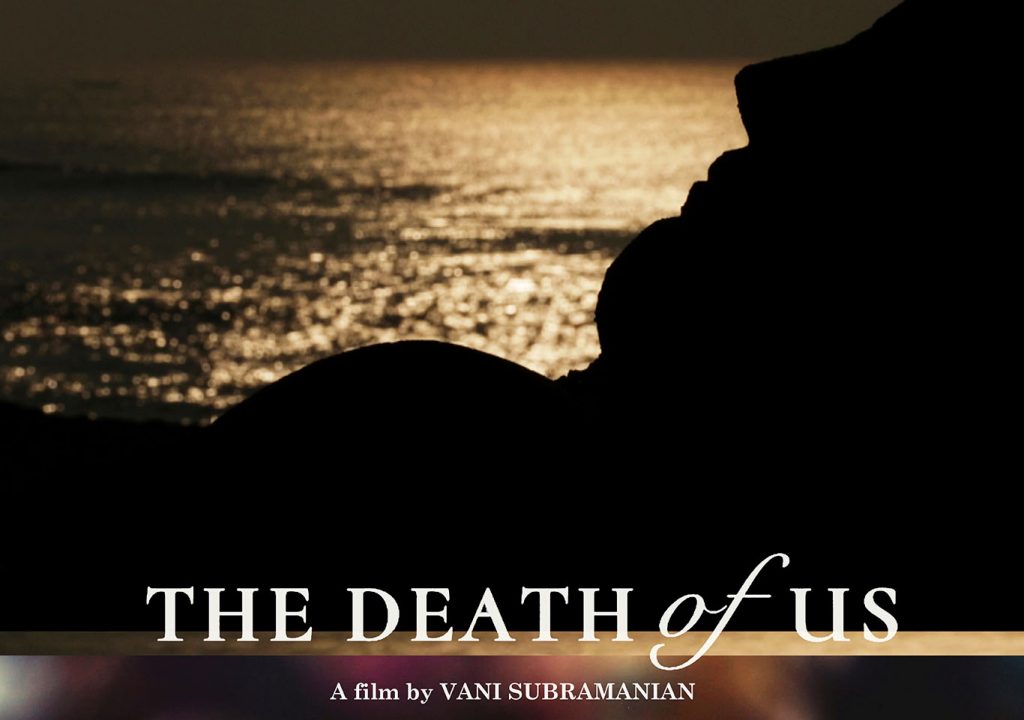Vani Subramanian switched from copywriting to feminist activism and documentary filmmaking. Her work as a filmmaker explores the connections between everyday practices and larger political questions, be they in the areas of culture, food production, primary education, urban development, communalism, sex selective abortions, or even matters of identity embedded in our food practices. Her films have been screened and have received awards, both nationally and internationally. She recently made a wonderful documentary called The Death of Us which is making news across film festivals. The film has been produced by the Public Service Broadcasting Trust in association with Doordarshan and Prasar Bharati.

‘The death of us’
The film is an ideal blend of aesthetics and documentation that covers interviews of actual convicts sentenced to hang for their crimes, and quotes the statistical data on hanging, features crimes that lead to the death sentence, and finally, points out the anomaly in the justice system that applies and executes the rule of law that raises questions on whether justice has truly be served or is biased against the poor, the marginalised and the underprivileged.
The film opens with a scene of a rope coiling and uncoiling unto itself captured through different angles in close-ups which, given the title of the film, is quite scary because you are actually looking at a rope made exclusively for hanging a man/woman sentenced to death. This makes for a shocking beginning to a film that is both informative and educative, and also entertaining in a certain sense. The voice-over states that these ropes are made in the Buxar Central Jail in Patna, Bihar. But it was closed when Vani was shooting the film and so, she could not include the shed where workers wove these ropes – thick, supple and made of Manila. A top prison official from the prison in which the death row convict is jailed, visits the work shed where inmates make the ropes to test the quality of the rope, and find out whether the rope as been tampered with. The rope is made on order from another prison.
When asked why she chose to use the rope as a visual metaphor, Vani says, “In obvious terms, it’s the means of carrying out an execution in India. While I didn’t want the film to be dramatic or grisly, I wanted the viewer to never forget that that was what this wide ranging conversation was really all about.”
This rope twists and turns like a snake before transforming itself into a hangman’s knot. A list of all the different crimes that are punishable by death in India follows, such as; (1) terror offences, (2) dacoity with murder, (3) murder, (4) abetting suicide by minors, (5) kidnapping, (6) sexual offences, (7) drug offences, and (8) rape of minors.
The actual cases
The film carries some very important interviews of men sentenced to death. The first among these is K. Thiagarajan who was born on the very day Mahatma Gandhi was assassinated. Around the 1970s, he joined the Naxalite Movement and became the first Tamil youth to join it. After meeting Charu Majumdar, he burnt his certificates and documents, left his family, and became an extremist. His sentence is linked to the Kilvelman case, the site of the first massacre of dalits in independent India. When dalit farm labourers, supported by the Communist Party fought for fair wages, the president of the paddy producers’ association, Gopal Krishna Naidu, decided to crush them to death.
On 25th December 1968, Naidu and 300 others attacked Kilvelman. They shot and knifed the people who scattered to save their lives. The rest were rounded up and set ablaze. There were 23 children, 16 women and five men all burnt to death. The attackers served light sentences or were released. Thirty dalit men got rigorous imprisonment, but Naidu remained free. The rebels in a revenge attack, after their first attempt failed, launched the second one. The main perpetrator, Thiruconam Muttuthangappa was a cruel landlord and a caste fanatic, and his crimes against women were notorious. Thiagarajan attacked him from behind and cut him up. Later, he was asked whether he would want to be an approver for a lighter sentence, but his mother told him not to betray his other two partners in this attack. The verdict was announced on 27th September 1970 in Thanjavur district, where for the homicide of one person, one received life imprisonment at the High Court, and three were sentenced to death.
This is just one of the cases the film discusses at length through detailed interviews with the death row convicts, which, we later get to know, ended in acquittal of most of them. The narrative and the voice-over is often intercut with lines of an Urdu poem by Faiz Ahmed Faiz recited in his own voice with the English translation. The recording is very old so the voice does not come out clear and lucid, so the magic of Faiz is somewhat dissipated.
The next person on death row to be interviewed is S. Chalapathi Rao imprisoned in Central Jail, Nellore, He was an extremely poor dalit who worked as a day labourer in Narsaro pet in Guntur district. He stepped into crime for reasons of poverty feeling that crime will give them a higher income. He has been sentenced to death for involvement in a bus robbery which led to 23 dead passengers and 14 injured.
The film quotes a paragraph from Bhagat Singh’s famous article “Why Am I An Atheist?” He writes, “What of a person who is born in a lower caste family? His fate is that people of higher castes will treat him with hate, disgust and scorn. His lack of education, his poverty and the contempt he faces from them will most likely harden his heart. If he commits a crime, who should be held responsible? God? Or, him? Or, the pandits and intellectuals of his society?”
Sculpting a cause
Sudarshan Pattnaik who is a noted sand sculptor at Konark, Odisha, lends the voice of balance to the film which repeatedly points out the tragic anomaly in carrying out the death sentence in India. “I was a child labourer,” he said. “But the minute I touched the sand, I felt – this is my canvas and my fingers were my pencils and colours. I firmly believe that social issues and current topics are what sculptures should be created around and I thought that the beach where I create so many sculptures can be seen by the thousands who come here for leisure. Also, lakhs of people have died here during the Tsunami.” He adds that his sand sculptures are his tribute to those who have laid down their lives and “that is my responsibility to society as an artist.” The camera pans across many sand sculptures created by Sudarshan Pattanaik.
Says the director Vani, “The sand artist, Sudarshan Pattnaik, has a somewhat mixed position – at one level he believes in frightening people with what will finally happen to you if you are a terrorist/rapist etc., through his works… but when you push him to it, he says there is no actual deterrence that the death penalty assures us of – so to my mind, he is sort of a mainstream opinion that propagates itself through popular art. I understood that my film was going to be seen in a pro-death environment, so didn’t feel like I need to reflect that in the film – hence it attempts to propose the counter to the pro arguments already in our heads/all around us.”
There are other interviews such as that of S.A.R. Geelani sentenced to death for the bombing on Parliament House on 13th December 2001 where 14 were dead and 18 injured with death for three and one given rigorous imprisonment. One of them has already been executed. Then the drug smuggling case at Palk Straits, Indian Ocean that happened on 29th November 2013, leading to three Sri Lankans and 5 Indians receiving the death sentence at the High Court in Colombo in Sri Lanka.
The film gives us some stunning statistics as follows. Of those sentenced, (a) 99% prisoners are very poor, (b) none of those involved in big scams reach the prison with few exceptions, (c) even if they do reach the prisons, their wealth protects them. Prison authorities do not care about when or whether Presidential clemency has been applied for, received or rejected because they just want to finish formalities and get the job done.
The All-India data on Death Row Inmates(2013 – 2015) reveal that:
84% of those who reach the Death Row and Life Sentence are uneducated and illiterate,
(2) 74% are economically weak,
(3) 65% are punished for the first time and
(4) 76% are SC/ST/Minorities.
The last word on this subject goes to Vani who says, “I wish I could have spoken to people on death row today… so we could hear what it means to be living, at this very moment, with the threat of execution hanging over you. What gives them hope? What causes despair? Do they have the energy to fight it, if so, where do they draw it from, etc… Because for me this film was not about comparing the pain caused by the original crimes to the survivors/loved ones of the victim or the pain that the capital punishment causes to those close to the person who is/may be hung. I wanted to give voice to people we don’t have a chance to listen to.”


 [/column]
[/column]